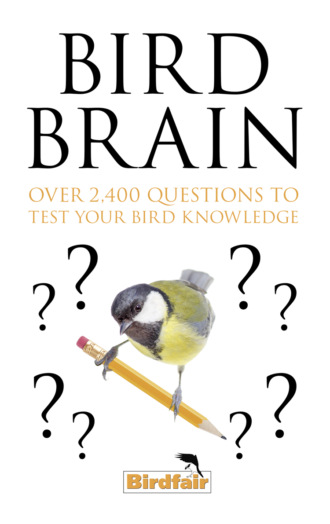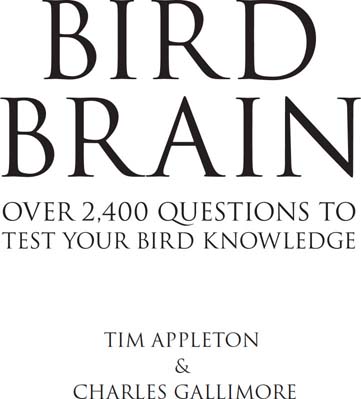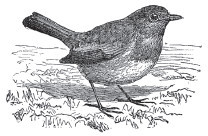
Полная версия
Bird Brain: Over 2,400 Questions to Test Your Bird Knowledge



Copyright
William Collins
An imprint of HarperCollinsPublishers
1 London Bridge Street
London SE1 9GF
WilliamCollinsBooks.com
First published in the United Kingdom by William Collins in 2018
This eBook edition published by William Collins in 2018
Copyright © Leicestershire and Rutland Wildlife 2018
Front Cover Photograph © Shutterstock
The authors assert their moral right to be identified as the authors of this work.
A catalogue record for this book is available from the British Library.
All rights reserved under International and Pan-American Copyright Conventions. By payment of the required fees, you have been granted the non-exclusive, non-transferable right to access and read the text of this eBook on-screen. No part of this text may be reproduced, transmitted, downloaded, decompiled, reverse engineered, or stored in or introduced into any information storage and retrieval system, in any form or by any means, whether electronic or mechanical, now known or hereinafter invented, without the express written permission of HarperCollins Publishers.
Source ISBN: 9780008315740
eBook Edition © October 2018 ISBN: 9780008315757
Version: 2018-08-09
Contents
Cover
Title Page
Copyright
Preface
History of Birdfair
30 Years of Global Impact
General Knowledge Questions
Specialist Questions
General Knowledge Answers
Specialist Answers
About the Book
About the Publisher

Preface
Bird Brain of Britain 2018
The Bird Brain of Britain competition at the Birdfair began in 1992 with the title Mastermind and it roughly followed the BBC’s successful programme of the same name. Distinguished ornithologists (Chris Mead, Janet Kear, Nigel Collar and Chris Harbard) volunteered to compete and Bill Oddie was the natural question master. It was a success and has continued ever since. The snappier title Bird Brain of Britain was thought of for 1995 and so it has remained. Leading ornithologists continued to ‘volunteer’ and Bill Oddie continued to grill them, for all but two of the next eighteen years, when Chris Packham was Inquisitor. In the last few years others filling the Torquemada role have been, besides Bill and Chris, Nick Baker, Mike Dilger and Stephen Moss.
The contestants set the Specialist questions (in theory). They are asked to provide ten questions each for the other three contestants so that there are thirty questions to ask. In practice, some questions are the same, some are unaskable and some are not absolutely correct. I have set the General Knowledge questions for the last eighteen years. I am uncertain who really set the questions in the early years before I was involved, but I was under the impression that Tim Dixon set them. However, as he won the 1993 contest, either somebody else did or …
The original competition was intended to be educational fun, but birders’ inherent competitiveness got in the way and it is now a cut-throat battle, the more so since a pecuniary prize of £2,000 was provided by the Catalan Tourist Board in 2007 and subsequently by Vanguard and Swarovski Optik. This is divided into £1,000 for the winner’s organization, £500 for second and £250 each for third and fourth. For the first ten years the contestants represented conservation organizations, namely the RSPB, BTO, BOU, BirdLife International, WWT and the Wildlife Trusts. Then other organizations were invited to put forward a hapless volunteer. The four regional bird clubs, ornithological journals, travel companies and optics companies provided cannon-fodder until 2007. Since 2007 contestants have represented the four regional bird clubs – African Bird Club (ABC), Neotropical Bird Club (NBC), Oriental Bird Club (OBC) and Ornithological Society of the Middle East (OSME), with BTO replacing NBC since 2012.
In 2004 we produced a book of the first twelve years and it was suggested another book covering the next fourteen years was fitting for the thirtieth Birdfair. Ornithology has changed quite a lot in the intervening years, with much greater knowledge about birds being acquired, much of it through the use of modern technology. This technology has resulted in frequent revisions of taxonomic classification, much of it confusing to more senior birders, and probably younger ones too. The Handbook of Birds of the World and BirdLife International Checklist seems to me the most rational taxonomy to follow, and is certainly the most user friendly, and so this has been adopted in this book. As a consequence there are quite a number of revised answers, as the original answers, though right at the time, may now be wrong, or at least different. This has been indicated to avoid confusion (with luck). Grey italic is used in the answers section (and a few in the questions too), to indicate the additions and changes.
The IUCN (International Union for Conservation of Nature) Red List categories of threatened birds are frequently mentioned and I have used the recognised abbreviations for the different categories, namely EX, for Extinct; EW, for Extinct in the Wild; CR, for Critically Endangered; CR (PE), for Critically Endangered Possibly Extinct; CR (PEW), for Critically Endangered Possibly Extinct in the Wild; EN, for Endangered; VU, for Vulnerable; NT, for Near Threatened; LC, for Least Concern; and DD for Data Deficient. The term Globally Threatened refers to the CR, EN and VU categories.
31st March 2018 was my cut-off date for updating. In the quiz some leeway has been given to the contestants for date and numerical answers, usually about 10 per cent, but this has been omitted in this book.
I have endeavoured to check and correct and update as many of the questions and answers as possible, particularly with taxonomic changes and matters of fact, particularly regarding a bird’s status. However, some answers I cannot verify and others I will have got wrong, and, of course, there will be some with which you do not agree. I accept full responsibility for all these errors of omission and commission. I have sometimes added a comment or an extra gobbet of information which I think is interesting or encouraging or depressing, but I have tried to keep my views to a minimum.

History of Birdfair
The concept of Birdfair was hatched in a local pub in Hambleton close to the shores of Rutland Water way back in 1987. Little did we realise all those years ago that this would start a trend of Birdfair’s across the globe.
The aim of Birdfair was to provide a market place for the growing ‘industry’ of birdwatching, be a meeting place for wild-life enthusiasts and to support a conservation project. Thirty years on Birdfair is the world’s largest wildlife event, bringing together over 70 countries and hosting almost 25,000 visitors annually. Birdfair has supported and funded global conservation projects from as far afield as Vietnam to Cuba, Ethiopia to Peru, Myanmar to Argentina. To date almost five million pounds has been donated to BirdLife projects in these areas – an incredible achievement for a three-day event!
On the commercial side Birdfair provides a platform for launching new products from optics, to bestselling natural history books to exotic wildlife holidays. Perhaps one of the biggest surprises has been the growth in eco-tourism – Birdfair is recognised as the ‘event’ to attend if you are contemplating a wildlife experience of a lifetime. Almost 50 per cent of the 395 stands offer individual and group trips. Although still dubbed as The Birdfair, wildlife organisations also attend representing bats, frogs, plants, butterflies, badgers and more.
Birdfair is more than just a hotspot for the commercial side of Birdwatching, thousands of visitors enjoy a weekend of entertainment. From the moment the gates open until way into the evening there are lectures, games, quizzes, talks, films, debates all supported by our wildlife celebrities. The Wild Zone provides younger visitors with the opportunity to engage directly with the fantastic wildlife of Rutland Water Nature Reserve, whether watching Ospreys, cruising on the water, pond dipping, bug hunting or just enjoying our annual wildlife Pantomime!
BirdBrain of Britain now in its 26th year attracts a huge audience, and thanks to generous sponsorship has helped the participating wildlife clubs raise tens of thousands of pounds for conservation projects in their regions.
The local economy is also a winner, as more and more visitors are staying for the whole three days. Hotels, B&Bs, Campsites, school boarding houses, restaurants bulge to capacity bringing huge financial benefits.
Over the years Birdfair has evolved bringing new attractions such as the highly successful Birdfair Auction raising well over £200,000, the Authors forum and the local produce tent. However none of this would have been achieved without the dedication of our staff and an incredible team of 470 volunteers.
From dawn to dusk for weeks before, during the event and for days after the crowds have left, this wonderful group can be justifiably proud that over the past 30 years they have played their part in creating and running the World’s largest Wildlife Event.
30 Years of Global Impact
Every year for the past three decades, the proceeds from Birdfair have gone to a conservation project, selected and managed by the conservation charity BirdLife International. Through your support, these projects have helped to secure a future for some of the world’s most threatened bird species and habitats – here are the highlights …
Year: 1989
Project name: ICBP Stop the Massacre Campaign
Birds that benefit: Migratory birds in the Mediterranean, focusing on the European Robin Erithacus rubecula
Amount raised: £3,000 ICBP (rebranded BirdLife in 1993) aimed to tackle hunting and trapping with the first Birdfair project. Birdfair supported an education programme lead by BirdLife Malta, which generated a huge amount of publicity and media coverage in Malta. However, the battle to end illegal bird killing is ongoing.
Year: 1990
Project name: Helping Save Spain’s Doñana National Park
Birds that benefit: Eurasian Spoonbill Platalea leucorodia, Black-winged Stilt Himantopus himantopus, Greater Flamingo Phoenicopterus roseus
Amount raised: £10,000
Already beleaguered by agriculture and tourism, Doñana wetlands faced its biggest threat with the proposal of a huge tourist development: ‘Costa Doñana’. Birdfair funded a concerted campaign led by SEO/BirdLife (BirdLife in Spain) which successfully halted the development, and financed a visitor centre to promote ecotourism.
Year: 1991
Project name: Danube Delta
Birds that benefit: Dalmatian Pelican Pelecanus crispus (NT), White-headed Duck Oxyura leucocepala (EN), Pygmy Cormorant Microcarbo pygmaeus
Amount raised: £20,000 The Danube Delta’s incredible wetlands suddenly escaped the threat of drainage when the new administration declared it a World Heritage Site and a Ramsar Site. However, new wardens lacked basic equipment. Birdfair funded the provision of binoculars, boat engines, bird hides and other essential kit.
Year: 1992
Project name: ICBP Spanish Steppes Appeal
Birds that benefit: Great Bustard Otis tarda (VU), Little Bustard Tetrax tetrax (NT), Dupont’s Lark Chersophilus duponti (NT)
Amount raised: £30,000 Despite supporting three-quarters of the world’s Little Bustards, Spain’s sweeping grasslands faced destruction by large-scale irrigation schemes funded by the EU. The Spanish Steppes campaign was one of the first truly effective examples of European-level collaborative conservation across the newly remodelled BirdLife International partnership.
Year: 1993
Project name: BirdLife International Polish Wetlands
Birds that benefit: Aquatic Warbler Acrocephalus paludicola (VU), Corncrake Crex crex
Amount raised: £40,000 Birdfair funded the Polish Society for the Protection of Birds (OTOP, BirdLife partner) to update its directory of wetland IBAs (Important Bird and Biodiversity Area) and seek effective protection for these areas. Funds also went towards Poland’s first reserve in the Swina Estuary to protect Aquatic Warblers. Such efforts have slowed this species’ decline in central Europe.
Year: 1994
Project name: Project Halmahera
Birds that benefit: Standardwing Bird-of-paradise Semioptera wallacii
Amount raised: £41,000 In 1994, Halmahera was the largest Indonesian island not to possess any National Parks or other protected areas. Focusing on this little-known tropical paradise raised much-needed awareness. Birdfair funded research to pinpoint priority areas for protection. Sadly, civil unrest in the area disrupted the process, but BirdLife clung on, and the first National Park was declared in 2004.
Year: 1995
Project name: Moroccan Wetlands Project
Birds that benefit: Slender-billed Curlew Numenius tenuirostris (CR), Marbled Teal Marmaronetta angustirostris (VU), Audouin’s Gull Larus audouinii (NT)
Amount raised: £45,000 Sandwiched between sea and desert, the wetlands along the Moroccan coast are a lifeline for migrating waterbirds. But they are also under pressure from human use. Birdfair funded the better management of key sites along this route, including school and community engagement programmes.
Year: 1996
Project name: Ke Go Forest Project
Birds that benefit: Edwards’s Pheasant Lophura edwardsi (CR), Crested Argus Rheinardia ocellata (NT), Red-collared Woodpecker Picus rabieri (NT)
Amount raised: £50,000 Ke Go is the last remaining block of lowland forest in central Vietnam. In 1996, with the publicity and financial backing of Birdfair, the site was declared a nature reserve. BirdLife continues to work in this area to combat the ever-present threat of illegal logging.
Year: 1997
Project name: Mindo Important Bird Area Project
Birds that benefit: Black-breasted Puffleg Eriocnemis nigrivestis (CR), Andean Cock-of-the-rock Rupicola peruvianus
Amount raised: £60,000 In 1997, with the help of Birdfair, Ecuador’s incredibly species-rich Mindo cloud-forest was declared the first IBA in the whole of South America, launching BirdLife’s IBA programme in that continent. BirdLife worked with the local community, developing ecotourism as an alternative livelihood to destructive agriculture.
Year: 1998
Project name: BirdLife International Threatened Birds Programme
Birds that benefit: Blue-throated Macaw Ara glaucogularis (CR), Spoon-billed Sandpiper Calidris pygmaea (CR), Whooping Crane Grus americana (EN)
Amount raised: £120,000 With one in eight bird species threatened with extinction, Birdfair funded research to gather up-to-date information on their populations, creating the landmark book Threatened Birds of the World. This sparked public and political awareness and established BirdLife as the avian authority for the IUCN Red List.
Year: 1999
Project name: Rescuing Brazil’s Atlantic Forests
Birds that benefit: Seven-coloured Tanager Tangara fastuosa (VU), Alagoas Antwren Myrmotherula snowi (CR), Bahia Tyrannulet Phylloscartes beckeri (EN)
Amount raised: £130,000 43 of Brazil’s 103 threatened bird species depend on its dwindling Atlantic forests. The 1999 Birdfair project aimed to preserve them. Successes included Murici Forest being declared an Ecological Station. BirdLife’s activity in this country eventually led to the formation of the NGO SAVE Brazil, now a BirdLife partner.
Year: 2000
Project name: Save the Albatross Campaign – Keeping the World’s Seabirds off the Hook
Birds that benefit: Seabirds including the Wandering Albatross Diomeda exulans (VU)
Amount raised: £122,000 Albatrosses are the most threatened group of seabird, and one of the biggest threats is death on the baited hooks of long-line fisheries. Birdfair funded the launch of the Global Seabird Programme, which paved the way for BirdLife’s highly successful Albatross Task Force.
Year: 2001
Project name: Eastern Cuba – Saving a Unique Caribbean Wilderness
Birds that benefit: Ivory-billed Woodpecker Campephilus principalis (CR – possibly still present in Cuba), Bee Hummingbird Mellisuga helenae (NT)
Amount raised: £135,000 Cuba hosts 350 bird species, including the world’s smallest bird, the Bee Hummingbird (weighing only 2 grams). Birdfair funded vital research, providing field equipment and setting up Cuba’s IBA network, which went on to attract conservation funding for the whole Caribbean.
Year: 2002
Project name: Saving the Last Lowland Rainforests in Sumatra
Birds that benefit: Red-naped Trogon Harpactes kasumba (NT)
Amount raised: £147,000 Birdfair funded the then newly formed BirdLife partner Burung Indonesia to identify priority areas of Sumatra’s dwindling lowland rainforest for protection. After intense lobbying, the government issued the very first forest restoration licence to preserve one such forest from logging and monoculture. This paved the way for BirdLife’s Harapan (‘hope’) Rainforest Project.
Year: 2003
Project name: Saving Madagascar’s Fragile Wetlands
Birds that benefit: Madagascar Fish-eagle Haliaeetus vociferoides (CR), Sakalava Rail Zapornia olivieri (EN), Madagascar Heron Ardea humbloti (EN)
Amount raised: £157,000 The plight of Madagascar’s forests is well publicised, but its wetlands are also of huge conservation importance. This project engaged local people who use the wetlands, working with governments, communities and businesses to draw up legal agreements. These have now expanded into two Protected Areas.
Year: 2004
Project name: Saving Northern Peru’s Dry Forests
Birds that benefit: White-winged Guan Penelope albipennis (CR), Marvelous Spatuletail Loddigesia mirabilis (EN), Long-whiskered Owlet Xenoglaux loweryi (EN)
Sandwiched between the Andes, the Sechura Desert and the Pacific Ocean, this isolated, enigmatic region is one of the top ten most biologically unique areas of the planet. Sadly, only 5% of its original range survives. Birdfair funded several successful, locally targeted community-based conservation projects.
Year: 2005
Project name: Saving Gurney’s Pittas and their Forest Home
Birds that benefit: Gurney’s Pitta Pitta gurneyi (EN)
Amount raised: £200,000 For much of the last century, Gurney’s Pitta was thought to be lost. The discovery of a population several hundred strong in Myanmar’s lowland forests was a fantastic event – but also an urgent one, with the forest threatened by clearance for oil palm plantations. Despite political unrest in the area, Birdfair-funded fieldwork greatly advanced our understanding of this bird.
Year: 2006
Project name: Saving the Pacific’s Parrots
Birds that benefit: New Caledonian Lorikeet Charmosyna diadema (CR), Rimatara Lorikeet Vini kuhlii (EN), Ouvea Parakeet Eunymphicus uvaeensis (EN)
Amount raised: £215,000 Islandbirds are at greater risk from extinction, especially from invasive species. Birdfair funded conservation across the Pacific region, focusing on six threatened parrot species. A major success involved Rima Lorikeets being reintroduced to their original home island of Aitu, where they now thrive.
Year: 2007
Project name: BirdLife International Preventing Extinctions Programme (PEP)
Birds that benefit: Bengal Florican Houbaropsis bengalensis (CR), Djibouti Francolin Pternistis ochropectus (CR), Belding’s Yellowthroat Geothlypis beldingi (now VU)
Amount raised: £226,000 Birdfair helped to kick-start BirdLife’s ambitious initiative to prevent Critically Endangered birds from slipping away. A highly effective network linked Species Champions (companies, organisations or individuals providing vital funds to save a species) with Species Guardians (leading targeted action on the ground).
Year: 2008
Project name: BirdLife International Preventing Extinctions Programme
Birds that benefit: Araripe Manakin Antilophia bokermanni (CR), Sociable Lapwing Vanellus gregarious (CR), Azores Bullfinch Pyrrhula murina (now VU)
Amount raised: £265,000 Building on the previous year’s success, a further six Critically Endangered birds were highlighted, and the search for Species Champions to ‘adopt’ them proved very successful. Birdwatch magazine devoted itself to the Azores Bullfinch, and Sir David Attenborough himself took on the Araripe Manakin.
Year: 2009
Project name: BirdLife International PEP: ‘Lost and Found’
Birds that benefit: Fiji Petrel Pseudobulweria macgillivrayi (CR), Makira Moorhen Pareudiastes silvestris (CR)
Amount raised: £263,000 Birdfair funded the PEP to establish whether 15 ‘lost’ species survived in the wild – thus informing conservation decisions. A successful example was the search for the Fiji Petrel, which uncovered 8 individuals. The PEP programme has gone on to appoint 46 Species Guardians, protecting 59 Critically Endangered birds.









